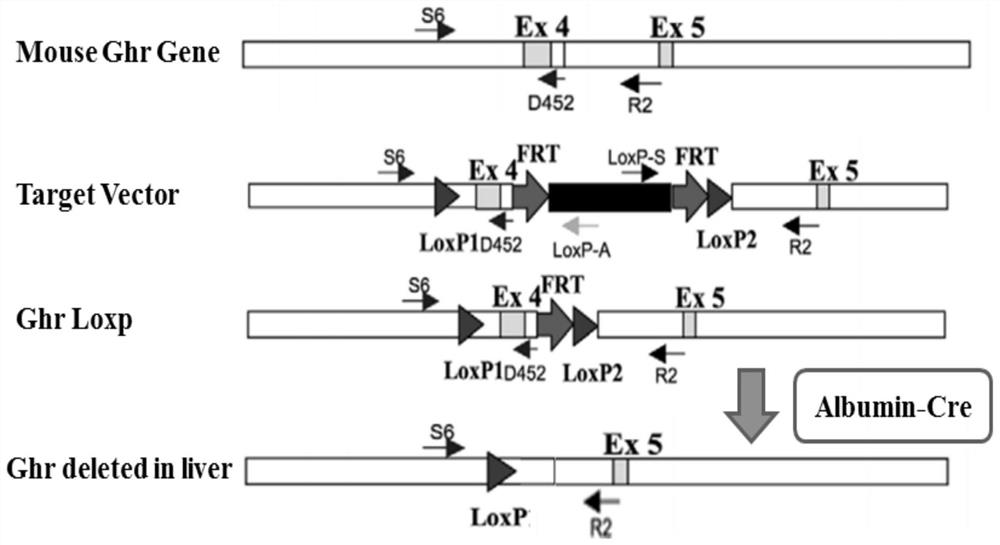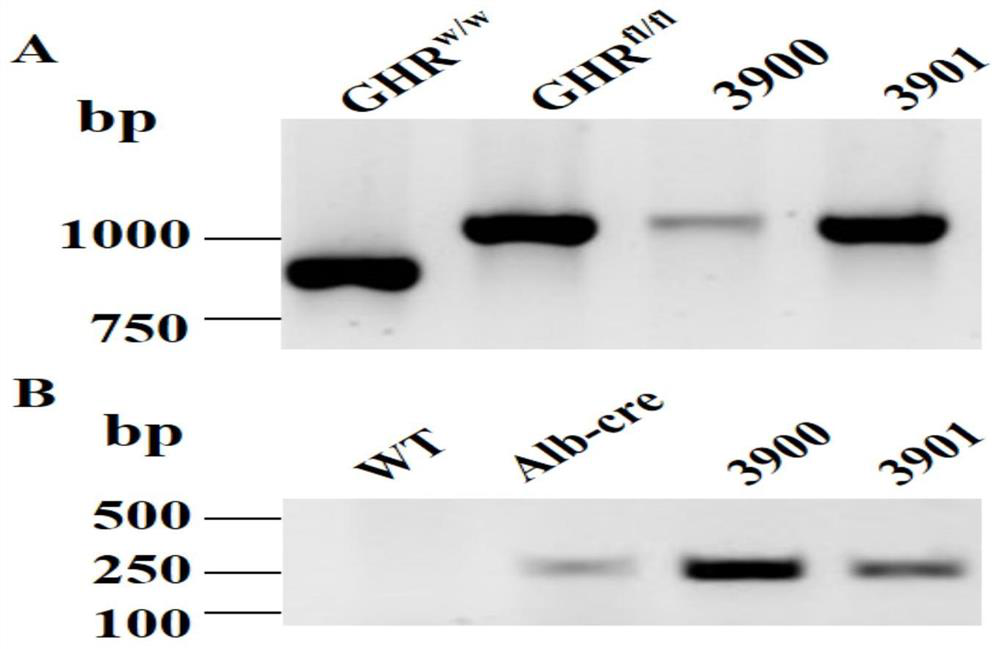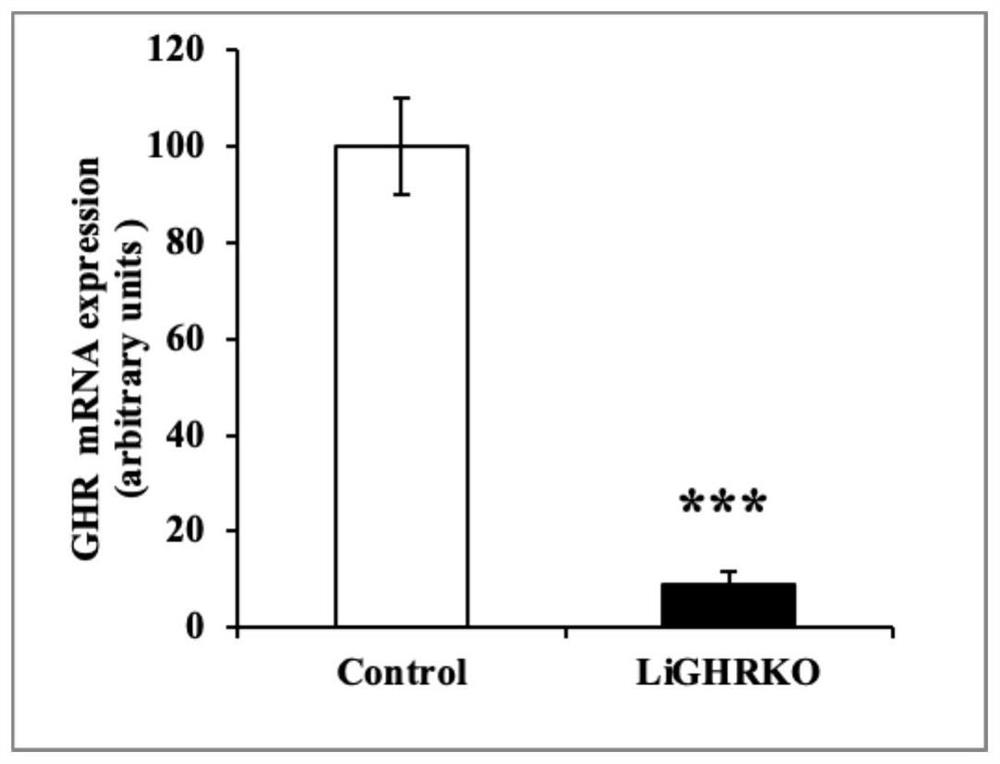Non-alcoholic fatty liver mouse model and construction method thereof
A mouse model, non-alcoholic technology, applied in the field of modeling technology of medical animal models, can solve the problems of low modeling success rate, long modeling time, limited models, etc., achieve short modeling time and reduce fat decomposition , the effect of increased fat synthesis
- Summary
- Abstract
- Description
- Claims
- Application Information
AI Technical Summary
Problems solved by technology
Method used
Image
Examples
Embodiment 1
[0029] The present invention provides such Figure 1-3 A non-alcoholic fatty liver mouse model and its construction method are shown, and the specific construction steps are:
[0030] Step 1: transfect mouse embryonic stem cells, use Pfu Turbo DNA polymerase to amplify and clone into the pCR Blunt II-TOPO vector containing the 4th and 5th exon fragment (size is 10.8kb) of ghr gene, described The pCRBlunt II-TOPO vector was purchased from Invitrogen, USA, and an 8kb fragment was excised from it with BamHI and XbaI, and then connected to the PL253 vector containing a thymidine kinase cassette (Thymidine kinase cassette) using T4 ligase. The PL452 and PL451 vectors containing the neomycin (neo) cassette were recombined and exchanged for this subcloned genomic region, and 2 Loxp sites and the Frt-neo-Frt-LoxP cassette were inserted to obtain a conditional targeting vector, which was restricted by Not I The conditional targeting vector was linearized by endonuclease digestion, and...
Embodiment 2
[0037] The present invention provides such Figure 1-6 A non-alcoholic fatty liver mouse model and its construction method are shown, and the specific construction steps are:
[0038] Step 1: transfect mouse embryonic stem cells, use Pfu Turbo DNA polymerase to amplify and clone into the pCR Blunt II-TOPO vector containing the 4th and 5th exon fragment (size is 10.8kb) of ghr gene, described The pCRBlunt II-TOPO vector was purchased from Invitrogen, USA, and an 8kb fragment was excised from it with BamHI and XbaI, and then connected to the PL253 vector containing a thymidine kinase cassette (Thymidine kinase cassette) using T4 ligase. The PL452 and PL451 vectors containing the neomycin (neo) cassette were recombined and exchanged for this subcloned genomic region, and 2 Loxp sites and the Frt-neo-Frt-LoxP cassette were inserted to obtain a conditional targeting vector, which was restricted by Not I The conditional targeting vector was linearized by endonuclease digestion, and...
Embodiment 3
[0045] The present invention provides such Figure 1-8 A non-alcoholic fatty liver mouse model and its construction method are shown, and the specific construction steps are:
[0046] Step 1: transfect mouse embryonic stem cells, use Pfu Turbo DNA polymerase to amplify and clone into the pCR Blunt II-TOPO vector containing the 4th and 5th exon fragment (size is 10.8kb) of ghr gene, described The pCRBlunt II-TOPO vector was purchased from Invitrogen, USA, and an 8kb fragment was excised from it with BamHI and XbaI, and then connected to the PL253 vector containing a thymidine kinase cassette (Thymidine kinase cassette) using T4 ligase, and then The subcloned genomic region was recombined and exchanged with PL452 and PL451 vectors containing a neomycin (neo) cassette, and two Loxp sites and a Frt-neo-Frt-LoxP cassette were inserted to obtain a conditional targeting vector, which was passed Not I Linearize the conditional targeting vector by restriction endonuclease digestion an...
PUM
 Login to View More
Login to View More Abstract
Description
Claims
Application Information
 Login to View More
Login to View More - R&D Engineer
- R&D Manager
- IP Professional
- Industry Leading Data Capabilities
- Powerful AI technology
- Patent DNA Extraction
Browse by: Latest US Patents, China's latest patents, Technical Efficacy Thesaurus, Application Domain, Technology Topic, Popular Technical Reports.
© 2024 PatSnap. All rights reserved.Legal|Privacy policy|Modern Slavery Act Transparency Statement|Sitemap|About US| Contact US: help@patsnap.com










